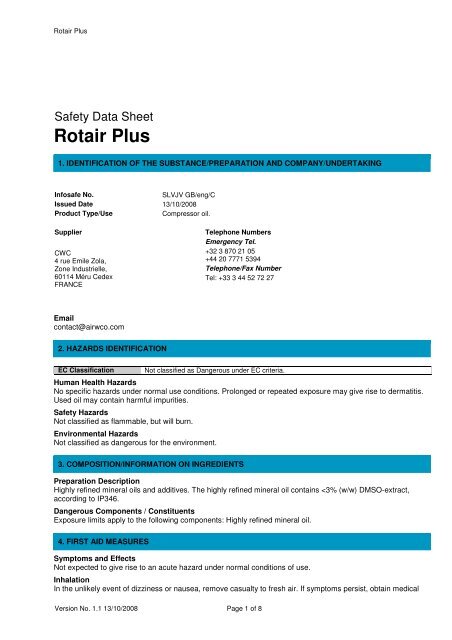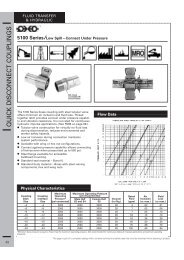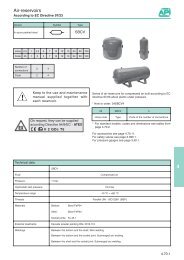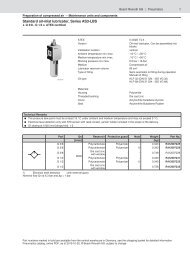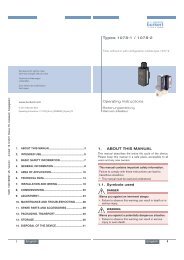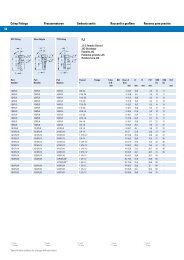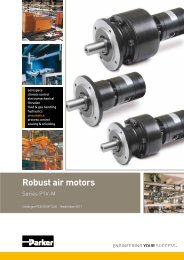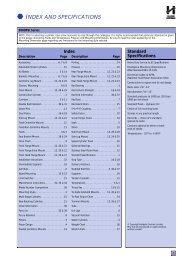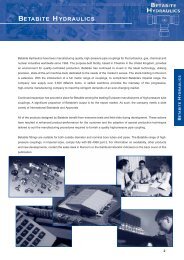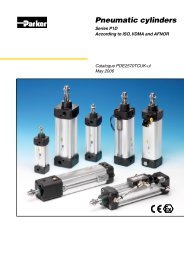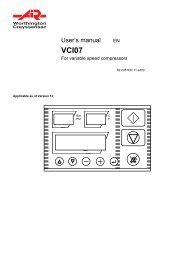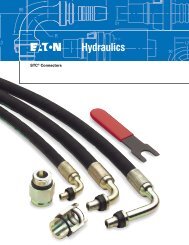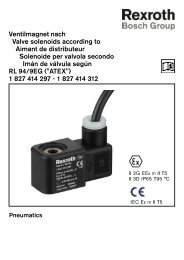Rotair Plus - Duncan Rogers
Rotair Plus - Duncan Rogers
Rotair Plus - Duncan Rogers
Create successful ePaper yourself
Turn your PDF publications into a flip-book with our unique Google optimized e-Paper software.
<strong>Rotair</strong> <strong>Plus</strong><br />
Safety Data Sheet<br />
<strong>Rotair</strong> <strong>Plus</strong><br />
1. IDENTIFICATION OF THE SUBSTANCE/PREPARATION AND COMPANY/UNDERTAKING<br />
Infosafe No.<br />
SLVJV GB/eng/C<br />
Issued Date 13/10/2008<br />
Product Type/Use<br />
Compressor oil.<br />
Supplier<br />
CWC<br />
4 rue Emile Zola,<br />
Zone Industrielle,<br />
60114 Méru Cedex<br />
FRANCE<br />
Telephone Numbers<br />
Emergency Tel.<br />
+32 3 870 21 05<br />
+44 20 7771 5394<br />
Telephone/Fax Number<br />
Tel: +33 3 44 52 72 27<br />
Email<br />
contact@airwco.com<br />
2. HAZARDS IDENTIFICATION<br />
EC Classification<br />
Not classified as Dangerous under EC criteria.<br />
Human Health Hazards<br />
No specific hazards under normal use conditions. Prolonged or repeated exposure may give rise to dermatitis.<br />
Used oil may contain harmful impurities.<br />
Safety Hazards<br />
Not classified as flammable, but will burn.<br />
Environmental Hazards<br />
Not classified as dangerous for the environment.<br />
3. COMPOSITION/INFORMATION ON INGREDIENTS<br />
Preparation Description<br />
Highly refined mineral oils and additives. The highly refined mineral oil contains
<strong>Rotair</strong> <strong>Plus</strong><br />
attention.<br />
Skin<br />
Remove contaminated clothing and wash affected skin with soap and water. If persistent irritation occurs, obtain<br />
medical attention. When using high pressure equipment, injection of product under the skin can occur. If high<br />
pressure injuries occur, the casualty should be sent immediately to a hospital. Do not wait for symptoms to<br />
develop.<br />
Eye<br />
Flush eye with copious quantities of water. If persistent irritation occurs, obtain medical attention.<br />
Ingestion<br />
Wash out mouth with water and obtain medical attention. Do not induce vomiting.<br />
Advice to Doctor<br />
Treat symptomatically. Aspiration into the lungs may result in chemical pneumonitis. Dermatitis may result from<br />
prolonged or repeated exposure. High pressure injection injuries require prompt surgical intervention and<br />
possibly steroid therapy, to minimise tissue damage and loss of function.<br />
Because entry wounds are small and do not reflect the seriousness of the underlying damage, surgical<br />
exploration to determine the extent of involvement may be necessary. Local anaesthetics or hot soaks should<br />
be avoided because they can contribute to swelling, vasospasm and ischaemia. Prompt surgical<br />
decompression, debridement and evacuation of foreign material should be performed under general<br />
anaesthetics, and wide exploration is essential. There may be a risk to health where low viscosity products are<br />
aspirated into the lungs following vomiting, although this is uncommon in adults. Such aspiration would cause<br />
intense local irritation and chemical pneumonitis. Children, and those in whom consciousness is impaired, will<br />
be more at risk. Emesis of lubricants is not usually necessary, unless a large amount has been ingested, or<br />
some other compound has been dissolved in the product. If this is indicated, for example, when there is rapid<br />
onset of central nervous system depression from large ingested volume - gastric lavage under controlled<br />
hospital conditions, with full protection of the airway is required. Supportive care may include oxygen, arterial<br />
blood gas monitoring, respiratory support, and, if aspiration has occurred, treatment with corticosteriods and<br />
antibiotics. Seizures should be controlled with Diazepam, or appropriate equivalent drug.<br />
5. FIRE FIGHTING MEASURES<br />
Specific Hazards<br />
Combustion is likely to give rise to a complex mixture of airborne solid and liquid particulates and gases,<br />
including carbon monoxide and unidentified organic and inorganic compounds.<br />
Extinguishing Media<br />
Foam and dry chemical powder. Carbon dioxide, sand or earth may be used for small fires only.<br />
Unsuitable Extinguishing Media<br />
Water in jet. Use of halon extinguishers should be avoided for environmental reasons.<br />
Protective Equipment<br />
Proper protective equipment including breathing apparatus must be worn when approaching a fire in a confined<br />
space.<br />
6. ACCIDENTAL RELEASE MEASURES<br />
Personal Precautions<br />
Avoid contact with skin and eyes. Wear PVC, Neoprene or nitrile rubber gloves. Wear rubber knee length safety<br />
boots and PVC Jacket and Trousers. Wear safety glasses or full face shield if splashes are likely to occur.<br />
Environmental Precautions<br />
Prevent from spreading or entering into drains, ditches or rivers by using sand, earth, or other appropriate<br />
barriers. Inform local authorities if this cannot be prevented.<br />
Clean-up Methods - Small Spillages<br />
Absorb liquid with sand or earth. Sweep up and remove to a suitable, clearly marked container for disposal in<br />
accordance with local regulations.<br />
Version No. 1.1 13/10/2008 Page 2 of 8
<strong>Rotair</strong> <strong>Plus</strong><br />
Clean-up Methods - Large Spillages<br />
Prevent from spreading by making a barrier with sand, earth or other containment material. Reclaim liquid<br />
directly or in an absorbent. Dispose of as for small spills.<br />
7. HANDLING AND STORAGE<br />
Handling<br />
Use local exhaust ventilation if there is risk of inhalation of vapours, mists or aerosols. Avoid prolonged or<br />
repeated contact with skin. When handling product in drums, safety footwear should be worn and proper<br />
handling equipment should be used. Prevent spillages. Cloth, paper and other materials that are used to absorb<br />
spills present a fire hazard. Avoid their accumulation by disposing of them safely and immediately. In addition to<br />
any specific recommendations given for controls of risks to health, safety and the environment, an assessment<br />
of risks must be made to help determine controls appropriate to local circumstances. Exposure to this product<br />
should be reduced as low as reasonably practicable. Reference should be made to the Health and Safety<br />
Executive's publication 'COSHH Essentials'.<br />
Storage<br />
Keep in a cool, dry, well-ventilated place. Use properly labelled and closeable containers. Avoid direct sunlight,<br />
heat sources, and strong oxidizing agents. The storage of this product maybe subject to the Control of Pollution<br />
(Oil Storage) (England) Regulations. Further guidance maybe obtained from the local environmental agency<br />
office.<br />
Storage Temperatures<br />
0ºC Minimum. 50ºC Maximum.<br />
Recommended Materials<br />
For containers or container linings, use mild steel or high density polyethylene.<br />
Unsuitable Materials<br />
For containers or container linings, avoid PVC.<br />
Other Information<br />
Polyethylene containers should not be exposed to high temperatures because of possible risk of distortion.<br />
8. EXPOSURE CONTROLS, PERSONAL PROTECTION<br />
Exposure Limits<br />
Substance Regulations Exposure Duration Exposure Limit Units Notes<br />
Oil mist, mineral EH 40 2005 TWA 5 mg/m3<br />
EH 40 2005 STEL 10 mg/m3<br />
EH 40 2005<br />
EH 40 2005 Health and Safety Executive. EH40; Workplace Exposure Limits<br />
Exposure Controls<br />
The use of personal protective equipment is only one aspect of an integrated approach to the Control Of<br />
Substances Hazardous to Health.<br />
The management of Health and Safety at Work Regulations 1992 require employers to identify and evaluate the<br />
risks to health and to implement appropriate measures to eliminate or minimise those risks. The choice of<br />
personal protective equipment is highly dependent upon local conditions, e.g. exposure to other chemical<br />
substances and micro-organisms, thermal hazards (protection from extremes of cold and heat), electrical<br />
hazards, mechanical hazards and appropriate degree of manual dexterity required to undertake an activity.<br />
Whilst the content of this section may inform the choice of personal protective equipment used, the limitations of<br />
any information which can be provided must be fully understood, e.g. personal protective equipment chosen to<br />
protect employees from occasional splashes maybe entirely inadequate for activities involving partial or complete<br />
immersion.If the levels of oil mist or vapour in air are likely to exceed the occupational exposure standards then<br />
consideration should be given to the use of local exhaust ventilation to reduce personal exposure.<br />
The choice of personal protective equipment should only be undertaken in the light of a full risk assessment by a<br />
suitably qualified competent person ( e.g. a professionally qualified occupational hygienist).<br />
Effective protection is only achieved by correctly fitting and well maintained equipment and employers should<br />
Version No. 1.1 13/10/2008 Page 3 of 8
<strong>Rotair</strong> <strong>Plus</strong><br />
ensure that appropriate training is given. All personal protective equipment should be regularly inspected and<br />
replaced if defective. Reference should be made to HSE's publication Methods for the Determination of<br />
Hazardous Substances (MDHS) 84 - Measurement of oil mist from mineral oil-based metalworking fluids.<br />
Measurement of an employee's exposure to oil vapour maybe supplemented through the use of stain tubes. In<br />
the first instance, further guidance maybe obtained through HSE's publication 'COSHH - a brief guide to the<br />
regulations' (INDG 136(rev1)).<br />
Respiratory Protection<br />
At standard temperature and pressure, the Occupational Exposure Standard for oil vapour is unlikely to be<br />
exceeded. Care should be taken to keep exposures below applicable occupational exposure limits. If this cannot<br />
be achieved, use of a respirator fitted with an organic vapour cartridge combined with a particulate pre-filter<br />
should be considered. Half masks (EN 149) or valved half masks (EN 405) in combination with type A2 (EN 141)<br />
and P2/3 (EN 143) pre-filters maybe considered.<br />
Hand Protection<br />
Chemical protective gloves are made from a wide range of materials, but there is no single glove material ( or<br />
combination of materials) which gives unlimited resistance to any individual or combination of substances or<br />
preparations. The extent of the breakthrough time will be affected by a combination of factors which include<br />
permeation, penetration, degradation, use pattern ( full immersion, occasional contacts) and how the glove is<br />
stored when not in use.<br />
Theoretical maximum levels of protection are seldom achieved in practice and the actual level of protection can<br />
be difficult to assess. Effective breakthrough time should be used with care and a margin of safety should be<br />
applied. HSE guidance on protective gloves recommends a 75% safety factor to be applied to any figures<br />
obtained in a laboratory test. Nitrile gloves may offer relatively long breakthrough times and slow permeation<br />
rates. Test data, e.g breakthrough data obtained through test standard EN374-3:1994 are available from<br />
reputable equipment suppliers.<br />
Personal hygiene is a key element of effective hand care. Gloves must only be worn on clean hands. After using<br />
gloves, hands should be washed and dried thoroughly. A non perfumed moisturiser should be applied.<br />
Eye Protection<br />
Goggles conforming to a minimum standard of EN 166 345B should be considered if there is a possibility of eye<br />
contact with the product through splashing. Higher rated eye protection must be considered for highly hazardous<br />
operations or work areas. For example, employees involved in metalworking operations such as chipping,<br />
grinding or cutting may require additional protection to avert injury from fast moving particles or broken tools.<br />
Body Protection<br />
Minimise all forms of skin contact. Overalls and shoes with oil resistant soles should be worn. Launder overalls<br />
and undergarments regularly.<br />
Environmental Exposure Controls<br />
Minimise release to the environment. An environmental assessment must be made to ensure compliance with<br />
local environmental legislation.<br />
9. PHYSICAL AND CHEMICAL PROPERTIES<br />
Colour<br />
Physical State<br />
Odour<br />
pH Value<br />
Vapour Pressure<br />
Initial Boiling Point<br />
Solubility in Water<br />
Density<br />
Flash Point<br />
Flammable Limits - Upper<br />
Flammable Limits - Lower<br />
Auto-Ignition Temperature<br />
Kinematic Viscosity<br />
Evaporation Rate<br />
Light brown.<br />
Liquid at ambient temperature.<br />
Characteristic mineral oil.<br />
Data not available.<br />
Expected to be less than 0.5 Pa at 20°C.<br />
Expected to be above 280°C.<br />
Negligible.<br />
875 kg/m3 at 15ºC.<br />
230ºC (COC).<br />
10%(V/V) (typical).<br />
1%(V/V) (typical).<br />
Expected to be above 320ºC.<br />
46 mm2/s at 40ºC.<br />
Data not available.<br />
Version No. 1.1 13/10/2008 Page 4 of 8
<strong>Rotair</strong> <strong>Plus</strong><br />
Vapour Density (Air=1) Greater than 1.<br />
Partition co-efficient, n-octanol/water Log Pow expected to be greater than 6.<br />
Pour Point<br />
-33ºC.<br />
10. STABILITY AND REACTIVITY<br />
Stability<br />
Stable.<br />
Conditions to Avoid<br />
Extremes of temperature and direct sunlight.<br />
Materials to Avoid<br />
Strong oxidizing agents.<br />
Hazardous Decomposition Products<br />
Hazardous decomposition products are not expected to form during normal storage.<br />
11. TOXICOLOGICAL INFORMATION<br />
Basis for Assessment<br />
Toxicological data have not been determined specifically for this product. Information given is based on a<br />
knowledge of the components and the toxicology of similar products.<br />
Acute Toxicity - Oral<br />
LD50 expected to be > 2000 mg/kg.<br />
Acute Toxicity - Dermal<br />
LD50 expected to be > 2000 mg/kg.<br />
Acute Toxicity - Inhalation<br />
Not considered to be an inhalation hazard under normal conditions of use.<br />
Eye Irritation<br />
Expected to be slightly irritating.<br />
Skin Irritation<br />
Expected to be slightly irritating.<br />
Respiratory Irritation<br />
If mists are inhaled, slight irritation of the respiratory tract may occur.<br />
Skin Sensitisation<br />
Not expected to be a skin sensitizer.<br />
Carcinogenicity<br />
Product is based on mineral oils of types shown to be non-carcinogenic in animal skin-painting studies. Other<br />
components are not known to be associated with carcinogenic effects.<br />
Mutagenicity<br />
Not considered to be a mutagenic hazard.<br />
Reproductive Toxicity<br />
Not considered to be toxic to reproduction.<br />
Other Information<br />
Prolonged and/or repeated contact with this product can result in defatting of the skin, particularly at elevated<br />
temperatures. This can lead to irritation and possibly dermatitis, especially under conditions of poor personal<br />
hygiene. Skin contact should be minimised. High pressure injection of product into the skin may lead to local<br />
necrosis if the product is not surgically removed. Used oils may contain harmful impurities that have<br />
accumulated during use. The concentration of such impurities will depend on use and they may present risks to<br />
health and the environment on disposal. ALL used oil should be handled with caution and skin contact avoided<br />
as far as possible.<br />
Version No. 1.1 13/10/2008 Page 5 of 8
<strong>Rotair</strong> <strong>Plus</strong><br />
12. ECOLOGICAL INFORMATION<br />
Basis for Assessment<br />
Ecotoxicological data have not been determined specifically for this product. Information given is based on a<br />
knowledge of the components and the ecotoxicology of similar products.<br />
Mobility<br />
Liquid under most environmental conditions. Floats on water. If it enters soil, it will adsorb to soil particles and<br />
will not be mobile.<br />
Persistence / Degradability<br />
Not expected to be readily biodegradable. Major constituents are expected to be inherently biodegradable, but<br />
the product contains components that may persist in the environment.<br />
Bioaccumulation<br />
Contains components with the potential to bioaccumulate.<br />
Ecotoxicity<br />
Poorly soluble mixture. May cause physical fouling of aquatic organisms. Product is expected to be practically<br />
non-toxic to aquatic organisms, LL/EL50 >100 mg/l. (LL/EL50 expressed as the nominal amount of product<br />
required to prepare aqueous test extract). Mineral oil is not expected to cause any chronic effects to aquatic<br />
organisms at concentrations less than 1 mg/l.<br />
Other Adverse Effects<br />
Not expected to have ozone depletion potential, photochemical ozone creation potential or global warming<br />
potential.<br />
Product is a mixture of non-volatile components, which are not expected to be released to air in any significant<br />
quantities.<br />
13. DISPOSAL CONSIDERATIONS<br />
Waste Disposal<br />
Recycle or dispose of in accordance with prevailing regulations, by a recognised collector or contractor. The<br />
competence of the contractor to deal satisfactorily with this type of product should be established beforehand.<br />
Do not pollute the soil, water or environment with the waste product.<br />
Product Disposal<br />
As for waste disposal.<br />
Container Disposal<br />
Recycle or dispose of in accordance with the legislation in force with a recognised collector or contractor.<br />
14. TRANSPORT INFORMATION<br />
Transport Information<br />
Not dangerous for transport under ADR/RID, IMO and IATA/ICAO regulations.<br />
ADR/RID Class<br />
None Allocated<br />
ADR/RID Packing Group<br />
None Allocated<br />
IMDG Hazard Class<br />
None Allocated<br />
IMDG Packing Group<br />
None Allocated<br />
IATA Hazard Class<br />
None Allocated<br />
IATA Packing Group<br />
None Allocated<br />
Version No. 1.1 13/10/2008 Page 6 of 8
<strong>Rotair</strong> <strong>Plus</strong><br />
15. REGULATORY INFORMATION<br />
EC Symbols<br />
EC Risk Phrase<br />
EC Safety Phrase<br />
EINECS<br />
TSCA (USA)<br />
None.<br />
Not classified.<br />
Not classified.<br />
All components listed or polymer exempt.<br />
All components in compliance.<br />
National Legislation<br />
Environmental Protection Act 1990 (as amended).<br />
Health and Safety at Work Act 1974<br />
Consumers Protection Act 1987<br />
Control of Pollution Act 1974<br />
Environmental Act 1995<br />
Factories Act 1961<br />
Carriage of Dangerous Goods by Road and Rail (Classification, Packaging and Labelling) Regulations<br />
Chemicals (Hazard Information and Packaging for Supply) Regulations 2002.<br />
Control of Substances Hazardous to Health Regulations 1994 (as amended).<br />
Road Traffic (Carriage of Dangerous Substances in Packages) Regulations<br />
Merchant Shipping (Dangerous Goods and Marine Pollutants) Regulations<br />
Road Traffic (Carriage of Dangerous Substances in Road Tankers in Tank Containers) Regulations<br />
Road Traffic (Training of Drivers of Vehicles Carrying Dangerous Goods) Regulations<br />
Reporting of Injuries, Diseases and Dangerous Occurences Regulations<br />
Health and Safety (First Aid) Regulations 1981<br />
Personal Protective Equipment (EC Directive) Regulations 1992<br />
Personal Protective Equipment at Work Regulations 1992<br />
Packaging & Labelling<br />
Safety data sheet available for professional user on request.<br />
16. OTHER INFORMATION<br />
References<br />
GUIDANCE NOTES<br />
UK Chemicals Regulatory Atlas, An Overview of how to guide your chemical through to regulatory compliance<br />
(DTI).<br />
HSG71 The storage of packaged dangerous substances.<br />
EH/40 Occupational Exposure Limits.<br />
EH/58 The Carcinogenicity of Mineral Oils.<br />
MS24 Health surveillance of occupational skin disease.<br />
HSG 53 The selection, use and maintenance of respiratory protective equipment: A practical guide.<br />
HSG 206 Cost and effectiveness of chemical protective gloves for the workplace: Guidance for employers and<br />
health and safety specialists.<br />
L74 First Aid at work: Approved Code of Practice and Guidance.<br />
HSG 136 Workplace transport safety : guidance for employers.<br />
INDG234 (rev) Are you Involved in the Carriage of Dangerous Goods by Road or Rail<br />
OTHER LITERATURE<br />
Concawe Report 3/82 Precautionary Advice on the Handling of Used Engine Oils<br />
Concawe Report 86/69 Health Aspects of Worker Exposure to Oil Mists<br />
Concawe Report 01/97 Petroleum Products - First Aid Emergency and Medical Advice<br />
Concawe Report 01/53 Classification and labelling of petroleum substances according to the EU dangerous<br />
substances directive ( Concawe recommendations August 2001)<br />
Concawe Report 01/54 environmental classification of petroleum substances summary data and rationale<br />
Concawe Report 5/02 amended safety data sheet directive ( 2001/58/EC)<br />
Department of the Environment - Waste Management - The Duty of Care - A Code of Practice<br />
Version No. 1.1 13/10/2008 Page 7 of 8
<strong>Rotair</strong> <strong>Plus</strong><br />
Concawe, Boulevard du souverain 165 B - 1160 Brussels, Belgium<br />
www.concawe.be<br />
Restrictions<br />
This product must not be used in applications other than recommended without first seeking the advice of the<br />
technical department.<br />
Further Information<br />
This information is based on our current knowledge and is intended to describe the product for the purposes of<br />
health, safety and environmental requirements only. It does not constitute a guarantee for any specific property<br />
of the product.<br />
... End Of SDS ...<br />
Version No. 1.1 13/10/2008 Page 8 of 8


